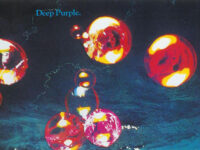Coming together in 1967, Deep Purple were like a lot of bands of the day, as their mission was to push the sonic envelope as far as possible and create something new and exciting. Based out of Hertford, England, the group achieved their goal straight away. Dramatic and bombastic, Deep Purple played a tumultuous blend of heavy metal and progressive rock before such labels arrived into being, tagging them pioneers of the genres.
In the beginning, Deep Purple featured lead singer Rod Evans, guitarist Ritchie Blackmore, bassist Nic Simper, organist Jon Lord and drummer Ian Paice. The band’s debut single, a cover of Joe South’s “Hush,” failed to cause ripples on the home front but penetrated the American airwaves with a vengeance, reaching as high as No. 4 on the charts in the summer of 1968. Set to a score of thundering rhythms, complemented by rivers of rollicking organ flourishes, the song flashed a doable mix of psychedelic residue and pop sensibilities — making it appealing to both the counterculture crowd and those who listened strictly to commercial radio.
Not long after “Hush” shook the public across the pond to its core, Deep Purple’s first album hit the racks. Released by Tetragrammon Records in July 1968, Shades of Deep Purple duly contained the band’s winning single. The band further salutes the Beatles via a slow, dark and gloomy version of “Help!,” while a similarly related treatment of “Hey Joe” — which at that point had been rehashed by nearly every band or artist one could point a finger at — clearly steals a page in the book from the Music Machine and Jimi Hendrix.
To be sure, Deep Purple didn’t hide their influences, but by extending the length of the tunes, adding layers of complex arrangements and slipping slivers of classical figures into the forum, they trekked a novel and industrious path.
The original material on Shades of Deep Purple includes “And the Address,” an instrumental built upon a soulful hard rock foundation, the wistful melodic pop of “One More Rainy Day,” and the gritty blues bluster of “Mandrake Root,” which concludes to a flaming acid-soaked jamboree of wicked guitar licks, rumbling drums and fancy pants organ escapades. A powerhouse rocker, “Love Help Me” pulsates and races to the catchy tone of meaty, beaty, big and bouncy Who styled harmonies, crashing chords and slashing hooks.
Deep Purple eventually encountered personnel changes, tightened their sound here and there, and ultimately gained status and respect as a premier hard rock band. Decades later, the group continues to ply their wares and show no sign of going away anytime soon. Good for Deep Purple!
- Why Aerosmith Finally Broke Through With ‘Get Your Wings’ - March 5, 2024
- How ‘The Birds, the Bees and the Monkees’ Blew Away Their Pre-Fab Image - April 10, 2023
- Steve Howe Made a Colorful, Quite Surprising Debut With Tomorrow - February 20, 2023




